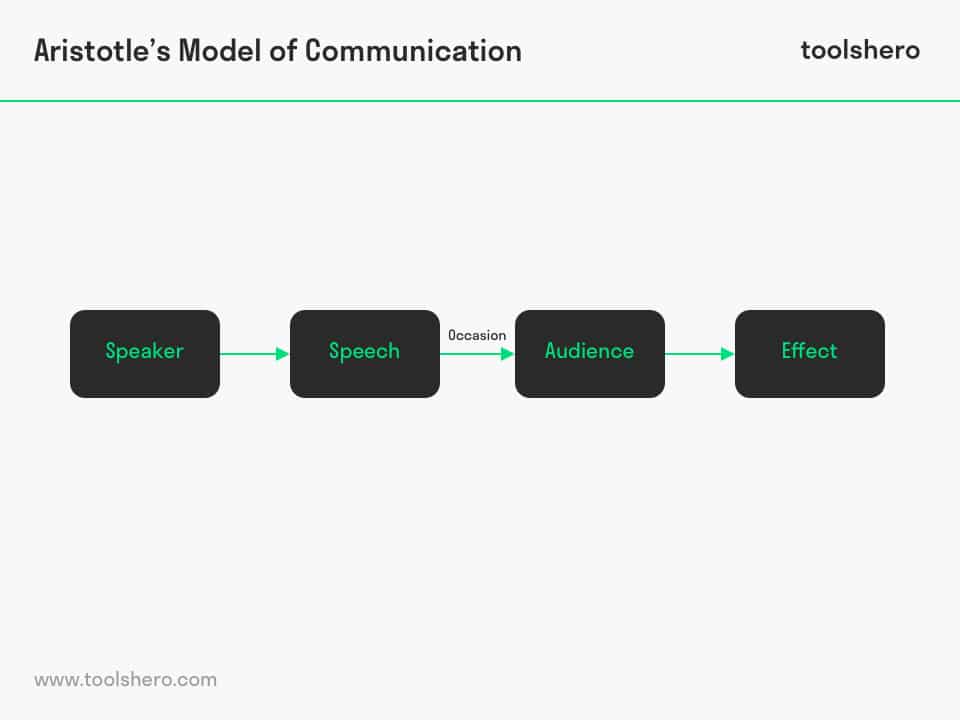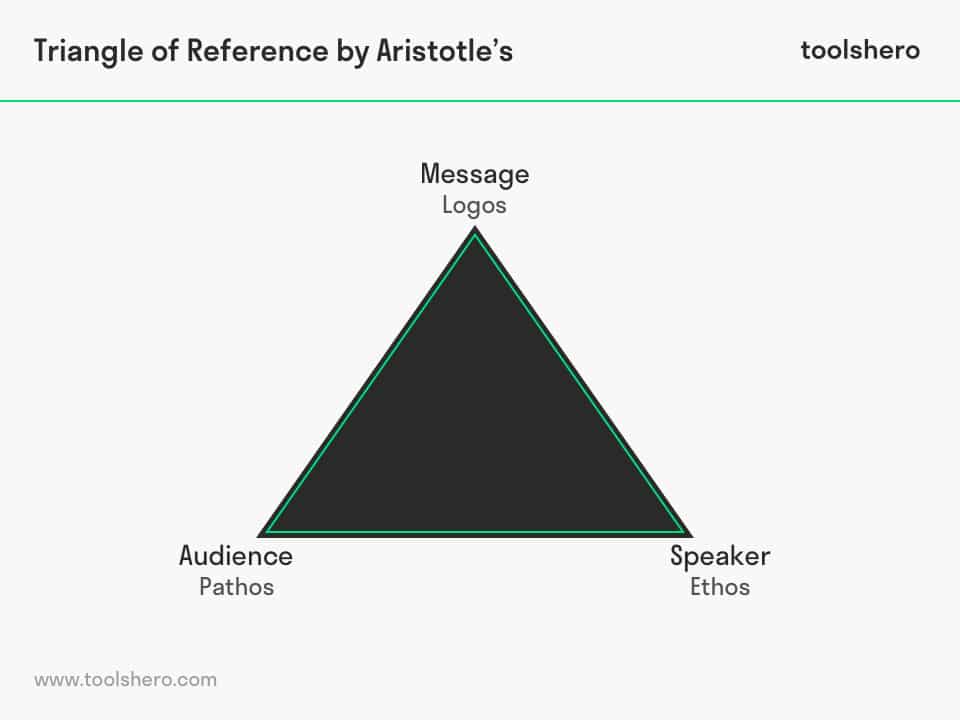Aristotle's Model of Communication Invention Arrangement Style Delivery
Aristotle Model of Communication

This article provides a practical explanation of the Aristotle Model of Communication. After reading, you'll understand the basics of this powerful communication tool.
What is Aristotle Model of Communication?
It was Aristotle who first proposed and wrote about a unique model of communication. Today, his model is referred to as the Aristotle Model of Communication. The great philosopher Aristotle already created this linear model before 300 BC, placing more emphasis on public speaking than on interpersonal communication. The simple model is presented in a diagram and is still widely used in preparing seminars, lectures and speeches to this day.
Aristotle model of communication diagram
The Aristotle Model of Communication diagram can roughly be divided into five elements. The speaker is the most important element, making this model a speaker-oriented model. It is the speaker's task to give a speech to the public. The role of the audience is passive. This makes the Aristotle Model of Communication a one-way model, from speaker to receiver.
Do you want unlimited and ad-free access?

The Role of the Speaker
According to the Aristotle Model of Communication, the speaker is the main figure in communication. This person is fully responsible for all communication. In this model of communication, it is important that the speaker selects his words carefully. He must analyse his audience and prepare his speech accordingly. At the same time, he should assume the right body language, as well as ensuring proper eye contact and voice modulations. In order to entice the audience, blank expressions, confused looks, and monotonous speech must be avoided at all times. The audience must believe in the speaker's ability to easily put his money where his mouth is.
An example. A politician (the speaker) gives a speech on a market square during an election campaign (the occasion). His goal is the win the votes of the citizens (the audience) present as well as those of the citizens potentially watching the speech on TV. The people will vote (the effect) for the politician if they believe in his views. At the same time, the way in which he presents his story is crucial in convincing his audience.
The politician talks about his party's standpoints and will probably be familiar with his audience. In other situations, it would be more suitable to actively research the audience in advance and determine their potential viewpoints or opinions.
The Rhetorical Triangle
The rhetorical triangle is essentially a method to organise and distinguish the three elements of rhetoric. The rhetorical triangle consists of three convincing strategies, to be used in direct communication situations. Aristotle did not use a triangle himself in the Aristotle Model of Communication, but effectively described the three modes of persuasion, namely logos, pathos, and ethos. These modes of persuasion always influence each other during conversations in which arguments are shared back and forth, but also in one-way communication, such as during speeches.

Ethos
Ethos is about the writer or speaker's credibility and degree of authority, especially in relation to the subject at hand. A doctor's ethos is the result of years of study and training. Due to his qualifications, a doctor's words involve a significant degree of authority.
One's ethos can be damaged in the blink of an eye, however. For example, the reputable politician may be found out when corruption scandals come to light and his private life turns out to be in complete contrast with his political standpoints. Tips for building ethos in communication:
- Use words that suit the target group
- Keep communication professional
- Conduct research before words are presented as facts
- Use recommendations from qualified experts
- Make logical connections and avoid fallacies
Pathos
The literal translation of pathos is emotion. In the rhetoric, pathos refers to the audience and the way in which they react to the speaker's message, the center in the Aristotle Model of Communication. The idea behind pathos is that the audience must feel that they are communicated with. In certain situations, they want to feel more confident, in others more sad, angry, or emotional. Before and during the Second World War, Adolf Hitler gave many speeches in front of tens of thousands of people. His words and particular pronunciation made his audience feel attracted to him. Pathos, emotion, can therefore also be abused. For example, people may become anxious as a result of the false consequences of not buying a product presented in the sales world. The question of whether emotions may be manipulated in sales strategies is a sensitive one. When collecting money for charities, this is somewhat socially acceptable. However, when selling products or services, many people will express their doubts. Nevertheless, capitalising on pathos can be very effective. Tips for effectively addressing emotions:
- People's involvement is stimulated by humour. Always keep different types of humour in mind, though
- Use images or other visual materials to evoke strong emotions
- Pay attention to the intonation and tempo of one's voice in order to elicit enthusiasm or anxiety
Logos
The direct translation of logos is logic, but in rhetoric it more broadly refers to the speaker's message and more specifically the facts, statements, and other elements that comprise the argument. According to the Aristotle model of communication, logos is the most important part of one's argument. For this reason, it is crucial that sales talks always emphasise this particular element. The appeal to logic also means that paragraphs and arguments must be properly ordered. Facts, statistics and logical reasoning are especially important here. When analysing logos, always ask yourself:
- What is the context? What conditions are relevant?
- What are the potential counter-arguments?
- Is there any evidence that supports my argument? Always mention this
- Do I correctly avoid generalisations and am I being specific enough?
An Example of Proper Use of Rhetoric
One man who understood rhetoric very well and applied it effectively was Steve Jobs, founder of Pixar Animation, NeXT, and Apple. He also applied the Aristotle model of communication effectively. This business guru stands head and shoulders above others of his generation in terms of communication techniques. Much research has been conducted into the ways in which he used to communicate a constant series of messages and themes about his company's products and his vision of the future.
Communication experts especially distinguish Steve Jobs' ethos. His degree of ethos, or credibility, had a major influence on how he used logos and pathos. If ethos was low, Steve Jobs would use high levels of pathos and low levels of logos. If ethos was high, he would use low levels of pathos and high levels of logos.
In addition to effective use of the rhetorical triangle, Jobs also used a mix of rhetorical strategies such as repetition, re-stirring of discussions to suit his vision and goals, and amplification. Amplification refers to a literary technique in which the user enhances a series of words by adding information to increase their value and comprehensibility.
Get Toolshero updates on new methods, models and theories!
Now it's your turn
What do you think? Are you familiar with the Aristotle model of communication? How do you think you can use this information to improve your communication skills? Do you have any additional tips for effective communication? Do you have any other suggestions or additions?
Share your experience and knowledge in the comments box below.
More information
- Kallendorf, C., & Kallendorf, C. (1985). The figures of speech, ethos, and Aristotle: Notes toward a rhetoric of business communication. The Journal of Business Communication (1973), 22(1), 35-50.
- Griffin, E. M. (2006). A first look at communication theory. McGraw-Hill.
- Braet, A. C. (1992). Ethos, pathos and logos in Aristotle's Rhetoric: A re-examination. Argumentation, 6(3), 307-320.
How to cite this article:
Janse, B. (2018). Aristotle model of communication. Retrieved [insert date] from toolshero: https://www.toolshero.com/communication-skills/aristotle-model-of-communication/
Add a link to this page on your website:
<a href="https://www.toolshero.com/communication-skills/aristotle-model-of-communication/a>
RECEIVE NEW ARTICLES + FREE GIFT
Join 13.000+ members who get frequently toolshero community updates! Including a free gift, the Business Model You template
No, close this pop-up
RECEIVE NEW ARTICLES + FREE TOOLSHERO TEMPLATE
Join 13.000+ members who get frequently toolshero community updates! Receive, next to new articles, the practical "Business Model You" template free of charge, to help you with your next professional and personal steps!
No, close this pop-up
Aristotle's Model of Communication Invention Arrangement Style Delivery
Source: https://www.toolshero.com/communication-skills/aristotle-model-of-communication/

0 Response to "Aristotle's Model of Communication Invention Arrangement Style Delivery"
Post a Comment